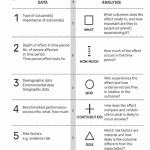Managing Trade-Offs Between Impact and Profit – Finding the Formula for BoP Business
The past decade, with the rise of interest in base of the pyramid (BoP) markets, has seen the emergence of an increased number of small enterprises, which provide “basic needs” products and services, training, education and employment opportunities to low-income markets. This large number of small enterprises active in BoP markets is interesting because (1) the initial call to approach BoP markets was targeted rather toward multinational corporations and (2) it revolutionizes the development sector, where a large number of initiatives are designed to support such enterprise-based solutions to poverty.
I recently conducted a large, empirical study with the aim of exploring such small initiatives in BoP markets, in particular to understand the nature of BoP enterprises, employed business models and achieved performance outcomes. (More details on the sample can be found here). The study reveals that a large number of small enterprises operating in BoP markets share similar characteristics and are founded to respond to highly pressing local issues (e.g. lack of clean water, malnutrition). The usual trajectory followed by enterprises in my sample starts with the identification of a social need and, subsequently, the exploitation (or development) of a market opportunity to address the social need.
While spotting a social need in BoP markets is rather easy, many entrepreneurs realize that some social needs are very hard to develop into viable economic models. This group of enterprises entails very strong social orientation and aims to combine social with economic objectives. (By social objectives, I refer to orientation toward societal development and local communities’ poverty alleviation. In this article, social objectives include ecological objectives). While one can argue that organizations usually pursue multiple objectives to a certain extent (e.g. balanced scorecard framework – financial, operational, customer and R&D goals), there is something unique about these BoP enterprises aiming to achieve social impact and economic self-sufficiency. Both a strong social mission and an economic viability vision are integral parts of their DNA, and the two logics co-exist within the enterprise. The two logics, economic and social value creation, are conflicting.
Tensions between them can have important consequences on the enterprise’s performance. For example, an enterprise with strong social orientation may prioritize projects, partners and resources related to the enterprise’s social mission at the expense of the economic goals. Although instrumental for the survival and success of BoP enterprises, the dynamics between the two logics, as well as the impact of the tensions between them, have been under-investigated by researchers. Also, this phenomenon has received little attention from practitioners.
two things we know about pursuing conflicting orientations
- They change throughout the venture development stages.
In the study I conducted, around one-third of enterprises reported an increased orientation toward economic goals from the early stages to date. While the reported social and ecological orientation remained constant, the change in economic orientation is alarming especially because the sample consists of relatively young ventures (between three and five years from the first business transaction). This finding is supported by other research. For example, Duncan Duke’s “Why Don’t BOP Ventures Solve the Environmental Problems They Initially Set Out to Address?” found that the initial ecological orientation of the enterprises changes in the light of numerous external and internal barriers in BoP markets. If BoP enterprises increase their economic orientation throughout the venture development stages, how much of the social orientation remains unaltered?
- They impact the economic performance and social impact of the enterprise.
In my study, I found that, as expected, strong social orientation drives the social impact of the enterprise in local communities, while the relationship between social orientation and economic performance is mediated by co-creation with BoP markets. Simply put, the strong social orientation determines enterprises to engage in co-creation with BoP actors, which in turn results in economic performance. Yet, the relationship between social orientation and social performance may be more complex.
A Harvard Business School study found that social orientation strengthens the social impact of the enterprise, but it can also weaken it by negatively affecting economic productivity. In other words, strong social orientation can be at odds with economic productivity inside the enterprise, which in turn can result in decreased social performance. The authors recommend that different groups within enterprises should be responsible for social activities and economic activities, respectively. Continuous interaction and exchange should take place between the two groups in order to discuss trade-offs.
Most inclusive business and BoP platforms, programs and reports focus largely on capital acquisition, technical advisory services and investment brokering. However, winning in BoP markets will require an effective management of trade-offs between social and economic logics, social and economic performance and relationships between the different logics and performance outcomes. While a lot of discussion has focused on developing local capabilities to approach BoP markets, I think BoP entrepreneurs have to adopt an inside-out perspective. They should develop a pragmatic understanding of their dominant logics and performance outcomes. Last, they should acquire skills, resources and capabilities for both social and economic activities.
Eugenia Rosca is a post-doctoral fellow at Jacobs University in Bremen, Germany.
Photo courtesy of BRACGlobal
- Categories
- Environment, Social Enterprise



